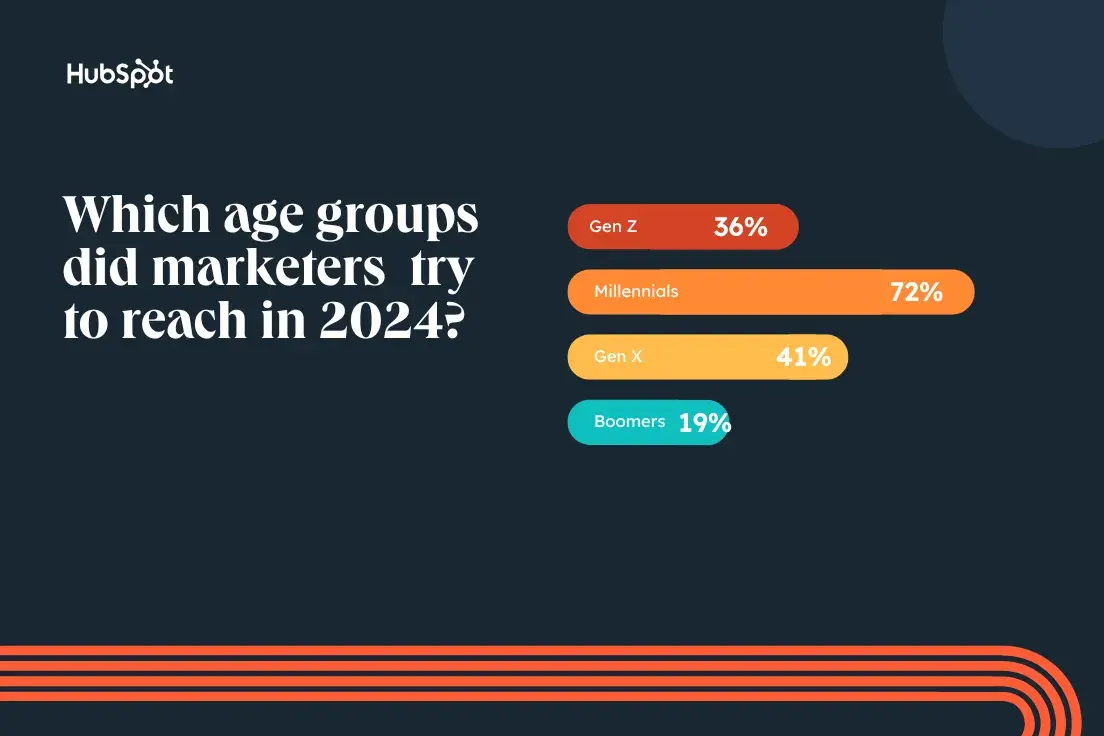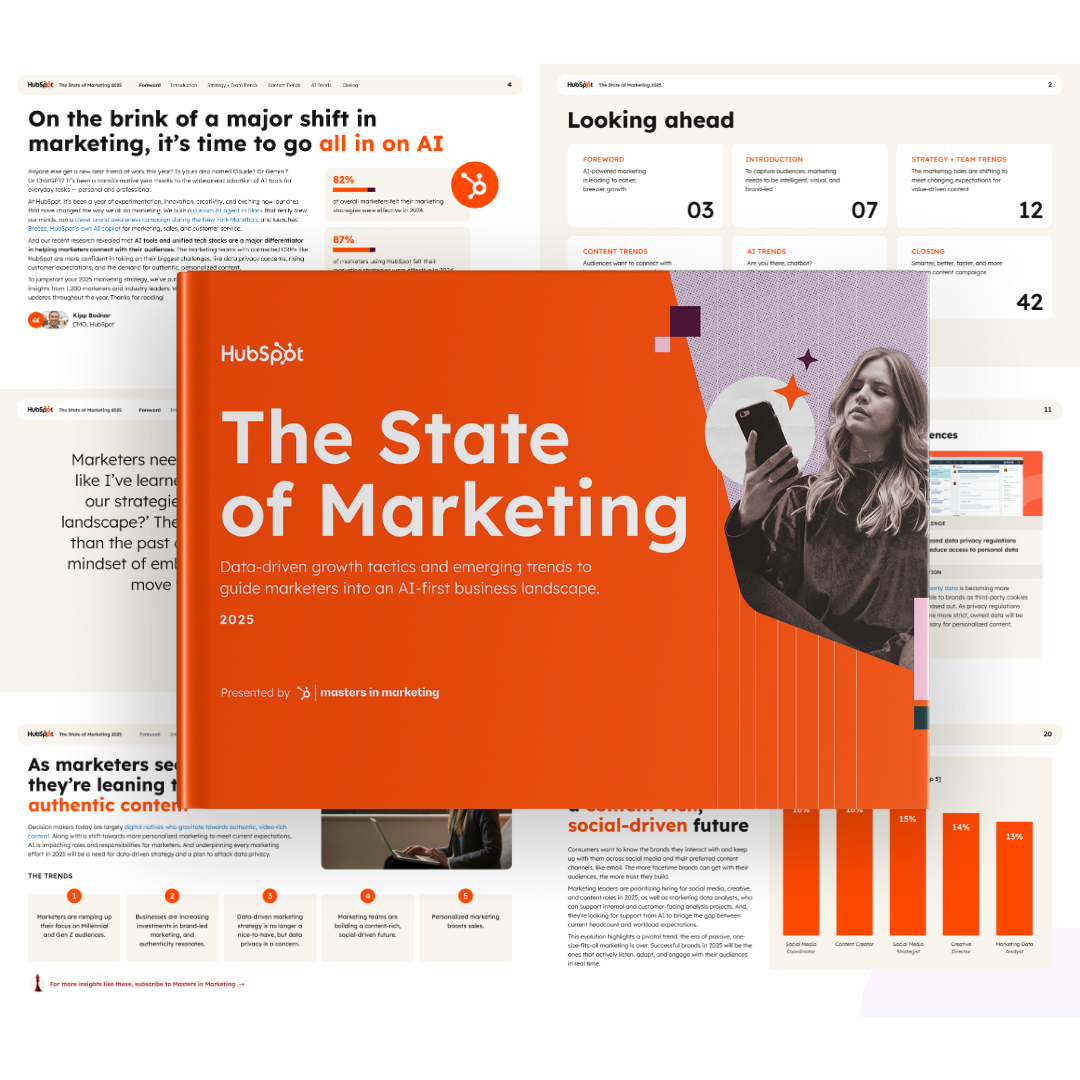Fortunately, I gathered all the information you need on the latest marketing trends — straight from industry experts and HubSpot's survey of 1,400+ global marketing professionals — and crafted this guide just for you.
Let's take a deep dive into marketing trends for 2024, shall we?
Table of Contents
- The Marketing Trends of 2025 (Highlights)
- The Top Content Marketing Trend
- The Top Social Media Marketing Trend
- Use Marketing Trends to Grow Better
The Marketing Trends of 2025 (Highlights)
- Brands will focus heavily on younger audiences, Gen-Z and Millennials.
- Brand-led marketing will see a resurgence, with a focus on brand values.
- Visual storytelling will dominate.
- It‘s the niche influencer’s time to shine.
- Data, data, data!
1. Brands will focus heavily on younger audiences, mainly Gen-Z and Millennials.
Our survey shows marketers are narrowing their scope to Gen-Z and Millennial consumers and are shifting almost entirely away from Boomer and Gen X. Specifically, the percentage of marketers maintaining their focus on Gen-Z and Millennials has remained about the same, but the percentages focused on Boomers and Gen-Z have plummeted.

In 2023, 67% of marketers were trying to reach Gen X, but by the end of 2024, that number dropped 41%. For Boomers, the number dropped from 27% to 19%.
This shift in priorities is likely because Gen Z is projected to see the fastest growth in spending power. Many experts estimate the generation will add almost $9 trillion in global spending—more than any other generation.
2. Brand-led marketing will see a resurgence, with a focus on brand values.
Our latest Consumer Trends Report found that 82% of consumers prefer to buy from brands that share their values. This is especially true for Gen Z, which is also known to support brands promoting authenticity.
So, it makes sense that as brands target younger Gen Z consumers, companies will shift to brand-led marketing that focuses on promoting the brand's missions, values, and ideals.
In fact, our Marketing Trends survey found that over a fifth of responding marketers (21%) will explore value-driven branded content in 2025.
One of my favorite examples of this comes from Nike. In one of its latest ads, Nike highlighted its support of women‘s sports and athletes. Women’s sports are seeing a huge boom in popularity lately, but misogyny, sexism, and discrimination are still hurdles athletes in the industry have to navigate.
The Nike ad below highlights several iconic female athletes and the brand's commitment to supporting them by providing high-quality apparel.
If you’re struggling to find content ideas relevant to your brand, you can use tools like HubSpot’s Blog Ideas Generator to kickstart your creativity.
Simply type in a few details about your brand, audience, and content, then choose a title that resonates with you the most. You can also take it a step further and generate outlines or blog posts that encapsulate your brand’s tone of voice.
3. Visual storytelling will dominate.
Last year, I said short-form videos would continue to rule, and this remains true: Most marketers (21%) report that the medium delivers the highest ROI.
“Video creates a deeper connection with your potential customer base, and it is easy for brands to repurpose video content into podcasts and text-based content,” Neil Patel, CMO and Co-Founder of NP Digital, says.
But short-form videos aren't the only visual medium marketers will flock to in 2025. Prepare to see a rise in more visual media, such as live streams and images. According to nearly 30% of marketers in our survey, images are the second most used format by marketers, behind short-form videos.
Our survey also shows that short-form videos, images, and live streams are the top three formats that deliver the highest ROI.

Out of the big three, I‘m the least surprised about live-streaming’s popularity among marketers. Live-stream shopping, or live shopping, has become pretty popular over the last few years, with 47% of Gen Z consumers in both the US and UK having made a purchase from live stream.
4. It‘s the niche influencer’s time to shine.
I can‘t scroll through social media without seeing influencers promoting all kinds of products, and I don’t see this trend slowing down in 2025. Last, 84% of marketers in our survey said they would increase their investment in influencer marketing in 2024.
In 2024, marketers still plan to leverage influencer marketing. However, this time, there will be a serious focus on micro and nano influencers. Micro influencers are influencers with 10,000-99,999 subscribers, and nano influencers have 1,000-9,999 subscribers.
This is largely because smaller influencers typically have more engaged audiences, and in 2024, most marketers reported seeing the most success with micro (44%) and nano influencers (22%).
5. Data, data, data!
In 2024, marketers and brands faced a considerable headwind when it came to collecting data to inform their strategies. These challenges stemmed from the EU‘s General Data Protection Regulation and upgrades from Google and Apple, which all mean to give consumers more power over their data and how it’s being shared.
These changes are great for the consumer but present trickier waters for brands to navigate. So, it's no surprise that marketers in our latest survey say increased data regulations are among the top data challenges facing marketers, just like last year.
These increased regulations lead to another top concern being poor data quality, plus 20% of marketers say consumers remain less trusting with their personal data.
But, data is still crucial in crafting successful marketing strategies and connecting to a target audience. In fact, 30% of marketers in our survey say data helps them understand which marketing strategies are most effective.
Here‘s my suggestion: To navigate these changes effectively, marketers need robust analytics tools that can provide valuable insights without relying heavily on third-party data. HubSpot’s Marketing Analytics & Dashboard software offers an easy-to-use solution, allowing businesses to track performance, analyze trends, and make data-driven decisions.
The Top Content Marketing Trend
At least 47% of buyers view three to five pieces of content before engaging with a sales rep, and most expect brands to create content to gain their interest. That's why brands worldwide have only grown their investments in content marketing.
But what content strategies are brands investing in? Below are just a few trends you'll want to follow in 2025.
6. Marketers will leverage AI to keep up with increasing content needs.
Of course, I'd be a fool to exclude the giant waves artificial intelligence made in 2024 and the changes it will bring in 2025. "Last year, 88% of marketers planned on investing the same amount or more into leveraging AI in 2024.
In 2025, marketers are interested in using AI to streamline content creation. Our survey found that 43% of marketers use AI to write copy, create images, and get new ideas.
This builds upon our findings from 2024 when 88% of marketers in our survey said they planned on investing in AI. Though there are concerns surrounding the use of AI, if you want your company to remain competitive in 2025 and keep up with demand, you‘ll likely want to look into leveraging different AI tools if you haven’t already.
Recently, I tried using AI to create a TikTok video, and it was surprisingly quick and easy. So, I‘d say it’s worth a shot.
Featured Resources
- 386+ Content Creation Templates
- TikTok AI: I Tried Creating a TikTok Using Only AI & Here's What Happened
The Top Social Media Marketing Trend
In the U.S. alone, 90% of the population actively uses social media.
This is why social media marketing is a popular channel that's become a part of almost every business’s greater marketing strategy.
Social media marketing allows you to authentically connect with your audience on a personal level, humanizing your brand.
7. Selling on social media will be even more normalized.
Many social media platforms are vying to become the next go-to shopping destination. Instagram has Instagram Shopping; Facebook has Facebook Shops; and TikTok is testing new e-commerce and partnership features.
This shift is already impacting consumer shopping habits. For instance, our State of Consumer Trends survey found that 40% of Gen Z-ers (18-24) have discovered new products on social media in the past 3 months.
Furthermore, the majority of Gen Zers in our survey (48%) said they'd like to learn about a product through a short-form video like a TikTok or Reel.
Featured Resources
- Top Shopping Trends of 2024 & How They've Changed [New Data]
- 30 Days of Instagram: A Guide for Businesses
Use Marketing Trends to Grow Better
You’re up to speed… for now. And, as long as you’re keeping a thumb on the pulse of marketing trends — and always remain open to change — your business won't fall behind.
But if you‘re feeling overwhelmed by the idea of keeping up with all these insights, don’t worry.
The HubSpot Blog will be publishing regular Marketing Strategy research pieces with data from hundreds of marketing professionals in the coming months and will continue to update this post as new trends emerge.
Editor's note: This post was originally published in August 2019 and was updated in March 2025 with updated HubSpot Blog trends data.
Marketing Trends

.jpg)

![4 shopping trends to expect in uncertain financial times [data + how marketers can adapt]](https://53.fs1.hubspotusercontent-na1.net/hubfs/53/consumer-recession-spend.webp)
![The Future Consumer: State of Consumer Trends in 2025 [Data from 700+ Consumers]](https://53.fs1.hubspotusercontent-na1.net/hubfs/53/consumer%20trends%202023-1.png)

.png)
![4 Marketing Trends & Strategies That Might Not Survive in 2025 [New Research]](https://53.fs1.hubspotusercontent-na1.net/hubfs/53/marketing%20trends%20that%20might%20not%20survive%202024.png)
![The HubSpot Blog's Marketing Leadership Report: How 720+ Brand Leaders Will Get Ahead in 2025 [+ How to Join Them]](https://53.fs1.hubspotusercontent-na1.net/hubfs/53/Copy%20of%20The%20Future%20of%20Work%20is%20Flexible%20%5BImage%2c%20IG%5D%20(598%20%C3%97%20398%20px)%20(595%20%C3%97%20400%20px)%20(517%20%C3%97%20517%20px).png)
![Top Shopping Trends of 2024 & How They've Changed [New Data]](https://53.fs1.hubspotusercontent-na1.net/hubfs/53/shopping-trends_3.webp)


![How Each Generation Shops in 2024 [New Data from Our State of Consumer Trends Report]](https://53.fs1.hubspotusercontent-na1.net/hubfs/53/how-each-generation-shops-1-20240801-5345961-1.webp)